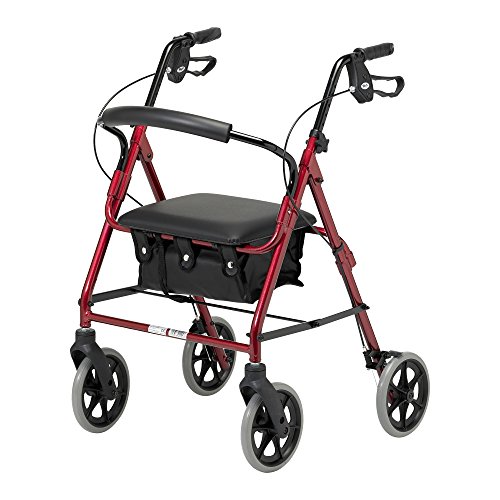Discussion Board
About Me
 What Is a Rollator Walking Aid?
What Is a Rollator Walking Aid?
A rollator walker foldable is a kind of walking aid which helps people maintain their balance. This is achieved by increasing the base-of-support (BoS) when walking.
It comes with brakes that can be easily engaged, and it is able lock when the user walks off or sits on the walker. Other features include a comfortable seat and baskets to store personal items.
Stability
Rollators provide more stability and mobility when compared to traditional walkers. They are a great choice for those who have trouble maintaining their balance or require a stable base when walking. These aids for mobility are designed to ease strain on healing muscles and joints, which can help promote faster recovery.
These mobility devices lessen the strain on joints in the lower extremities as well as reducing strain on muscles. This is achieved by distributing the weight across a larger area, which may help reduce the peak pressure on the forefoot while walking downhill or walking on an uneven surface. The use of these devices could also help reduce pain in the forefoot by redistributing high plantar pressure to other areas of the foot.
The frame of a rollator is an important element in terms of stability, as this is what supports the weight of the user. The frame is usually constructed from strong materials such as steel or aluminum which ensures that the device won't collapse or buckle under the pressure. Furthermore, the brakes on the handle on a rollator are a vital security feature for users, helping them to slow down or stop if they are moving too fast or picked up too much speed.
The frame of a rolling walker is a very stable structure, however it has its limitations. For example the weight and size of the wheels can significantly impact how the device performs in different situations. Certain studies have revealed that the use of a walker with huge wheels causes the center of gravity to shift slightly to the left, which could negatively impact the way the device is utilized.
This is not a problem in the majority of situations however it must be considered when buying an walker. Many experts recommend using a walker with smaller wheels for those who intend to spend a lot of time outside or in different walking conditions. The height of the handles is also crucial to ensure that they are at the correct height for the user. This will help prevent shoulder and wrist pain as well as wrist fatigue.
Support
Rollators are more sturdy than traditional walkers, with a frame to support the user. They also have four wheels which distribute weight evenly and assist users in navigating different terrains without falling. This allows them to remain active both indoors and outdoors and live a full life with greater confidence. Rollators can also be customized with different features, such as adjustable handles brakes, wheels, and dimensions to meet your specific needs. Some models are also equipped with storage and backrest options for everyday comfort and mobility.
While a rollator offers improved stability, it is essential to use it correctly to prevent accidents. It is recommended that a doctor or physical therapist supervise your transition to using an aid for mobility. They can prescribe the device for you and recommend the best one for your situation.
It is also essential that you adhere to the manufacturer's instructions on how to use your rollator. This will ensure that it's properly adjusted to the right height and that it is fitted to your body type. To enhance the functionality of your device, you need to keep it clean and well-lubricated.
When using a rolling walker ensure that you put your weight on the base of the unit, not on the wheels. Leaning on the wheels can cause a safety risk and could cause it to tip over. Also, never allow a child to ride on top of your mobility aid. This could cause the wheels to wear faster because of the pressure.
The cost could deter some from using a walking aid. Financial assistance and insurance coverage can help offset the cost. Medicaid and Medicare for instance, classify a rollator or walker as durable medical equipment. This means that they can cover a part of its costs. In addition flexible spending accounts (FSAs) and health savings accounts (HSAs) can be used to cover the cost of these devices too. In the end, a all terrain rollator can be an affordable and efficient tool that will allow you to remain mobile and self-sufficient.
Easy to Use
Rollators are a great choice for those who require additional support, but want to be mobile. It is simple to use and can be folded up when not being used. A rollator can also help reduce pressure on joints and muscles, and improve balance, which can help with overall walking performance.
A typical rollator consists of frames that have between two and four wheels. The wheels make it simple to move as you don't have to lift the frame each time. Some models even have seats so that you can relax when needed.
Research is still ongoing but it is believed that walking with a walker may reduce the load on certain joints and muscle groups. This could result in the strength needed for other activities and movements, such as stair-climbing or balance control while standing or squatting. This could contribute to the chance of falling in elderly rollator users.
It's important to find a walker or a rollator that feels comfortable for the user. The handle should be held at the same level as the knee nearest to it, but away from the body. When a walker is held too close to the body could cause strain on the neck, back, and arms. The grip of a rolling walker is also important. If the grip is not comfortable or does not meet an individual's needs then you can replace it with a different style. If the handle is too small or hard, a grip made from foam, plastic, or another soft material might be more comfortable.
It is also important to note that the walker or rollator should be kept at an appropriate distance from the floor so as to avoid putting too much stress on the feet and legs. This will reduce the risk of slipping and twisting the knee or ankle. It's important to have a backup device (like a cane or crutches) to use in the event that the rolling walker becomes unstable for any reason. It's not recommended to set the rollator down for prolonged durations, particularly on uneven ground or stairs.
Convenience
A rollator is a useful mobility aid for those who are unable to walk long distances or suffer frequent falls. It reduces the force and strain on injured muscles or joints. It can also increase confidence and increase social interaction. It is important to consider the cost of a rollator as well as how your insurance will cover it. Many Medicare Part B policies classify walkers and rollators as durable medical equipment which means they'll cover a portion of the cost once you've met your annual deductible. Medicaid will typically also cover these devices.
Some people use rollators as an alternative to a walker or cane, but it's best to use these other devices to provide stability and support when walking. A walker, for instance can help you maintain straight posture by keeping your arms level with your hips. You can also keep it at a comfortable distance that is supportive from your body. This can help prevent awkward postures that can result in a twisted ankle or knee.
It's important to remember that if you choose to use a walker, you should never hold it in front of your body or close. The handlebars of a normal walker usually rise above the user's arms, which can cause wrist flexion torque. This can result in forefoot pain and a hallux rigidus due to the reduction of strength of the flexor muscles in the arms and hands. A walker that rolls reduces this issue by lowering the handles to a level that is more in line with the styloideus ulnae.
Another aspect of convenience is that many rollators have a seat that can be used while you're on the go or in public places. This is particularly helpful when you're shopping and want to relax and sit down and rest your feet. Some models have an extra tray that is placed on top of the seat. This lets you carry drinks or snacks while walking around.
Consider whether your chosen device has storage for things like your keys, phone and wallet. Some models are designed with a basket on the front of the frame, whereas others have a storage compartment under the seat. Some walking strollers, such as those available at Essential Aids, even have an accessory strap for backpacks that makes it easy to transport.
Location
Occupation
Latest Post: Kamagra vs Viagra, any experience? Our newest member: hollymacgroarty Recent Posts Unread Posts Tags
Forum Icons: Forum contains no unread posts Forum contains unread posts
Topic Icons: Not Replied Replied Active Hot Sticky Unapproved Solved Private Closed

